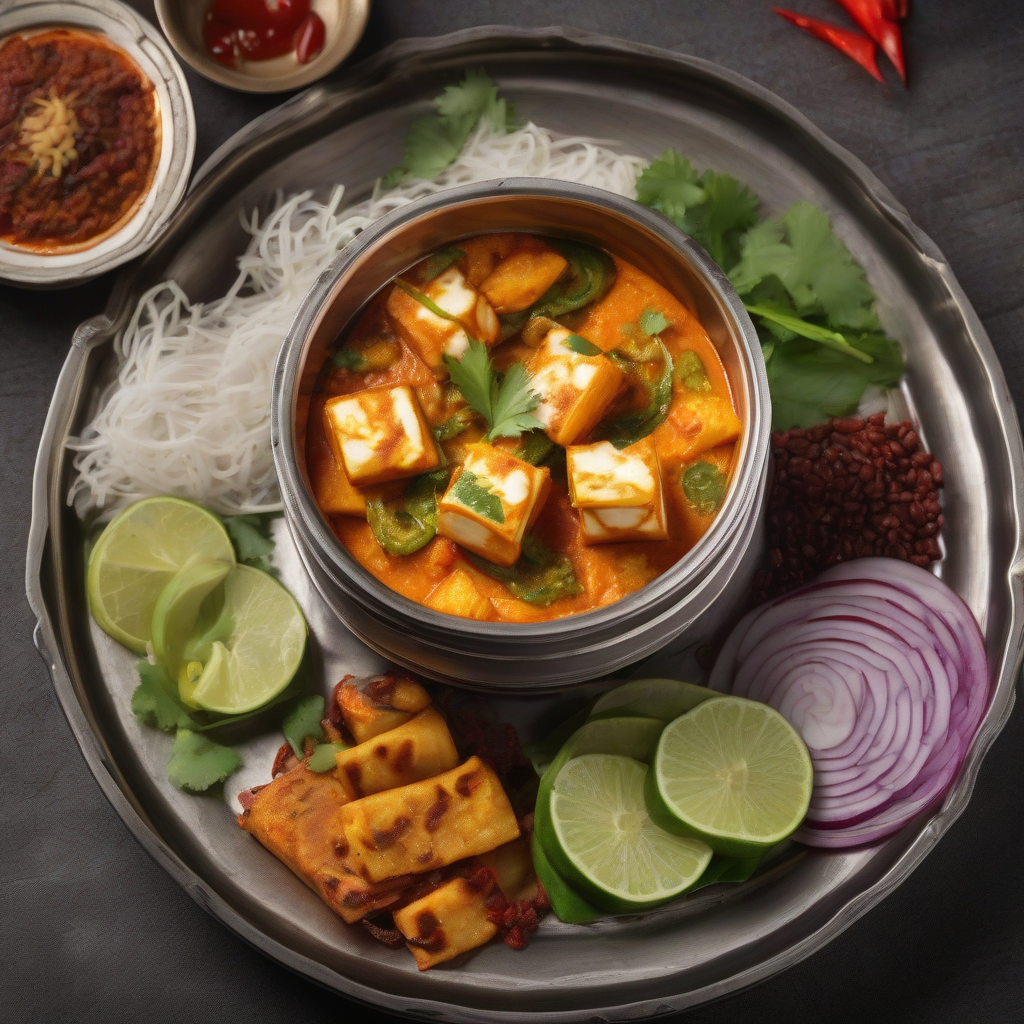Aye Mere Pyaare Doston! Get Ready for a Scrumptious Paneer Thukpa!
Namaste, Mitron! Sat Sri Akal! Kem Cho? Chef Curry Do’pyaza here, ready to tantalize your taste buds with a delightful Indo-Tibetan fusion dish: Paneer Thukpa!
This vibrant, flavourful noodle soup is like a warm hug on a chilly evening. It’s the perfect comfort food, especially during the Losar festival in the Himalayan regions, or when the winter winds howl through your windows. Families gather, sharing steaming bowls of Thukpa, celebrating togetherness and good fortune. It’s also a common meal during Buddhist festivals and celebrations.
A Little Trip Down History Lane
Thukpa originates from Tibet, where it’s a staple food. Over time, it journeyed across the Himalayas, picking up Indian influences along the way. This Paneer Thukpa is my own twist, a delicious marriage of Tibetan tradition and Indian flavours. It’s a hearty, vegetarian version that even the most dedicated meat-eaters will adore!
Ready to Cook? Here’s What You Need:
- Preparation Time: 20 minutes
- Cooking Time: 30 minutes
Ingredients (Serves 4):
- 200g Paneer (Indian Cottage Cheese), cut into small cubes
- 1 tbsp Tel (Cooking Oil)
- 1 medium Pyaaz (Onion), finely chopped
- 1 inch Adrak (Ginger), grated
- 2-3 Lahsun (Garlic) cloves, minced
- 1 Hari Mirch (Green Chili), finely chopped (adjust to your spice level!)
- 1 medium Gajar (Carrot), julienned
- 1 medium Shimla Mirch (Capsicum/Bell Pepper), thinly sliced
- 1/2 cup Patta Gobhi (Cabbage), shredded
- 4 cups Vegetable Broth (or Chicken Broth for non-vegetarians)
- 1 tbsp Soy Sauce
- 1 tbsp Sirka (Vinegar) – Rice Vinegar is best!
- 1 tsp Lal Mirch Powder (Red Chili Powder)
- 1/2 tsp Haldi Powder (Turmeric Powder)
- Salt to taste
- 200g Noodles (Egg noodles or Hakka noodles work great!)
- Hara Dhaniya (Fresh Coriander Leaves), chopped for garnish
- 1 Lemon, cut into wedges for serving
Let’s Get Cooking!
- Paneer Power: Heat 1 teaspoon of oil in a pan. Gently fry the paneer cubes until golden brown. This adds a lovely nutty flavour and prevents them from crumbling in the soup. Set aside.
-
Aromatic Base: In a large pot or wok, heat the remaining oil. Add the chopped onion and sauté until it turns a beautiful golden brown.
-
Ginger-Garlic Magic: Add the grated ginger, minced garlic, and chopped green chili. Sauté for a minute until fragrant. The aroma will fill your kitchen!
-
Veggie Fiesta: Add the julienned carrots, sliced capsicum, and shredded cabbage. Sauté for 3-4 minutes until the vegetables are slightly softened but still have a pleasant crunch.
-
Broth Bonanza: Pour in the vegetable broth (or chicken broth). Add the soy sauce, vinegar, red chili powder, turmeric powder, and salt. Bring the mixture to a boil.
-
Noodle Nirvana: Add the noodles to the boiling broth. Cook according to the package instructions until they are perfectly tender.
-
Paneer Perfection: Gently stir in the fried paneer cubes. Let them simmer in the soup for a couple of minutes to absorb the flavours.
-
Garnish & Serve: Ladle the hot Paneer Thukpa into bowls. Garnish generously with fresh coriander leaves and serve with lemon wedges. A squeeze of lemon juice adds a zesty kick!
Chef Curry’s Top Tips for the Best Thukpa:
- Don’t overcook the vegetables! You want them to retain some crunch for a delightful texture.
- Adjust the spice level to your liking. Feel free to add more or less green chili and red chili powder.
- Use good quality broth for a richer, more flavourful soup. Homemade broth is always the best!
- Fry the paneer for a better taste and texture.
- Add a pinch of sugar to balance the flavors.
Thukpa Your Way: Cooking Options Galore!
- Gas Stove/Induction Stove: The traditional method, perfect for simmering and controlling the heat.
- Pressure Cooker: For a quicker version, sauté the vegetables and spices in the pressure cooker. Add the broth and noodles, then pressure cook for 2-3 whistles. Release the pressure naturally before adding the paneer.
- Slow Cooker/Crockpot: A fantastic option for a hands-off approach. Sauté the vegetables and spices, then transfer them to the slow cooker with the broth. Cook on low for 6-8 hours or on high for 3-4 hours. Add the noodles and paneer in the last 30 minutes.
- Microwave: Not recommended for the entire recipe, but you can use it to quickly heat up leftovers.
Nutritional Information (Approximate, per serving):
- Calories: 350-400
- Protein: 20-25g
- Carbohydrates: 40-45g
- Fat: 15-20g
Note: This is an approximate value and can change based on the ingredients used.
Serving Suggestions:
- Serve hot with a side of momos or steamed dumplings.
- Add a dollop of chili garlic sauce for an extra kick.
- Enjoy it as a light lunch or a comforting dinner.
Now It’s Your Turn!
Go ahead, my dear friends, and try this amazing Paneer Thukpa recipe at home. It’s easier than you think, and the results are absolutely divine. Share the joy by cooking it for your loved ones. Let me know how it turns out in the comments below!
